
Juli 02
<
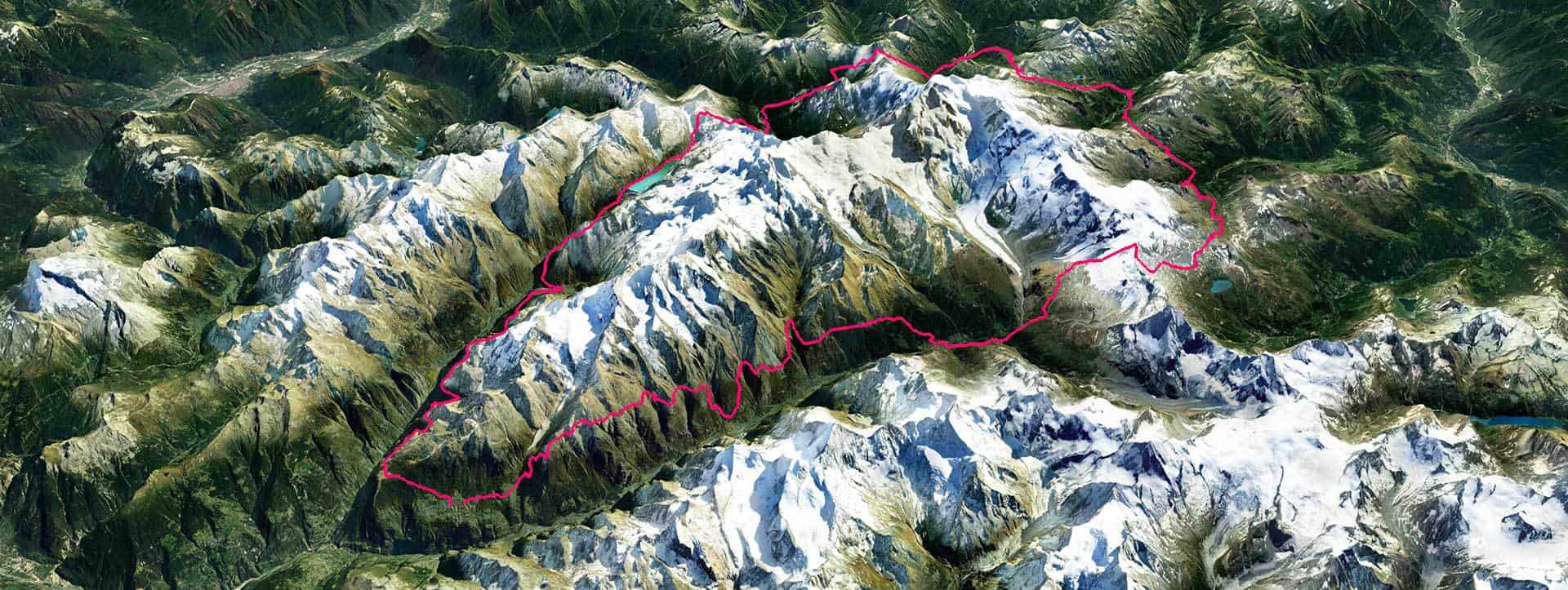
On 29th July 2016, Lizzy Hawker completed a full tour of Monte Rosa solo, to „test the course“. Here is what she wrote back then in answer to five questions about the route.
You started at the same time as the race will start next year, so passed around the route as a mid pack runner would. What should they look out for – what are the major challenges the Monte Rosa course will present to them?
A mid-pack runner will reach the top of the first climb out of Grächen and be onto the high balcony path of the Europaweg as dawn breaks. On this FKT I was alternately under and within a bank of cloud. But if it is clear then the alpenglow on the Weisshorn before sunrise will be something special to see. This balcony path runs across spectacular wild terrain high above the valley floor.
The major challenges of the route are just the relentless ascents and descents, the exposure to alpine conditions (the weather at 3300m might not be the same as low in the valley) and the isolation of some stretches of the route.
What difference does it make to do this distance and elevation change alone without the support of race infrastructure?
The full tour is pretty tough, whether racing or making an FKT. But there are a few differences. Firstly, when doing an FKT there is no support if something goes wrong or if you make a misjudgement. You have to be confident that you can rely on your own ability and experience. The Alps are not a true wilderness area, of course, but you still have to be confident with your level of risk. Then, food and drink can be a challenge. I made a foot trip around the race route the week before my FKT because I had some meetings with the mountain guides and some other logistics to fix. I took the opportunity to hide a couple of things under rocks and leave a few bags with friends along the way. I think I deposited three pairs of socks and a miscellaneous variety of food in plastic bags. It wasn’t very thought through, just a last ditch attempt to prepare in case I did try the FKT. In the event, I didn’t pick up some of the stuff, thinking I’d be quicker just using the local shop/coop, and much of the food I’d deposited wasn’t really what I felt like eating after X tough hours on foot.
In Alagna I was lucky a friend waited until 11pm to meet me. And in Macugngaga a hard night meant I passed through at breakfast time instead of during the dead hours of 3-4am. However you put it, when you make a ‚more-or-less‘ unsupported FKT you have to be running well enough within your comfort zone that you can make choices and decisions. You have to be able to look after yourself and push yourself onwards, otherwise everything falls apart. Conversely when you make the same journey within a race situation, yes the route is just as difficult, but there is infrastructure in place to support you.
What was the hardest part of the 37 hours for you and why?
The hardest part of the 37 hours for me was the night. Training since Lavaredo has been all or nothing and sleep has been insufficient. So whereas in the past I have comfortably gone through two nights and then had a tough time with the third nightfall, this time the first (only) night was difficult. That and getting myself out of the door to begin with to start the journey with no witness and no reason why other than curiosity.
What is your prediction for the fastest elite men and women’s times for 2017?
30-32 hours for the women, 26-30 hours for the men
What one piece of advice would you give to someone consider entering for the 2017 ultra?
Don’t arrive short on sleep! This does of course depend on family and work commitments but starting with a sleep deficit will make the night hours extra tough. You need to be well trained but well rested. Beyond that the only thing I would say is enjoy it. It is a wild and beautiful mountain journey and it will push you further than you think is possible, physically, mentally, emotionally.
Jan. 10
<

The route of the Ultra Tour Monte Rosa is challenging! Bold, beautiful and brutal …. There are two reasons why we ask for the experience we ask for – we want you to be safe and we want you to enjoy your race experience.
It is a tough trail – high, wild and technical in places. The terrain is demanding and the weather conditions can be too. You may be exposed to snow, rain, wind, intense sunshine, heat. The weather can change quickly and you need to be prepared for everything.
Imagine you fall and twist an ankle and you are waiting for help to arrive. You are sitting on cold rocks just below a 3000m pass in the pouring rain with the wind howling. Can you look after yourself until help arrives? There is also a reasoning behind the obligatory equipment that we ask you to carry!
We are offering four different race options so that you can choose the challenge that suits your experience and aspirations.
The stage races are a wonderful way to experience the UTMR. You can race as hard as you like during the day and then enjoy the companionship of your fellow runners as you relax and recover in delightful alpine villages. With no night-time running you are able to enjoy each section of the route in daylight. The 4-day stage race covering the full tour is 40% harder than the 3-day stage race starting in Cervinia. Bear this in mind when deciding which race to enter!
We suggest prior experience of multi-stage racing on mountain terrain or completion of a mountain marathon with up to 2000m ascent within a time of 8 hours. More important than speed is the ability to look after yourself in the mountains in potentially severe weather conditions – this is why we ask if you have any previous mountain experience – this might include climbing or mountaineering, multi-day trekking, ski alpinism (not downhill piste skiing) etc.
Running one of the UTMR ultras means you are going to be running during the hours of darkness, possibly for all of one or even two nights. It is essential that you are sufficiently comfortable on alpine trails to be able to cope when you are tired, your eyes are strained from trying to see in the dark and your legs are exhausted. You need to be in good physical shape and you need to be mentally prepared.
The 116km Ultra from Cervinia to Grächen is a real challenge. We ask you to have experience of a race of at least 100km on mountain trails and requiring you to run over 6 hours during darkness on rocky mountain trails (not smooth single track).
The 170km Ultra Tour making the full loop around Monte Rosa from Grächen to Grächen is a serious challenge. This is the race that I wanted to run and this is why we created the UTMR! For 2017 the number of participants is limited to 100. We ask that you have already completed one of 5 races of comparable difficulty. Note that in my opinion the UTMR is at least 30% harder than the UTMB.
“The full UTMR course is going to destroy runners that think it’s just another long run in the mountains,” said Fergus Edwards from UK who recced the new course over four days last summer. “This is not a race that you turn up at and hope to hike the ups, jog the downs, and make it back tired but inside the cutoffs. Two key reasons: firstly, the ascents and descents are longer and steeper than other races; secondly, the terrain is very technical with boulder fields and narrow paths clinging to steep mountain slopes.”
Please choose the event that gives you a challenge appropriate to your experience. If you have any questions then please do get in touch and we hope to welcome you in September!
Sep. 20
<
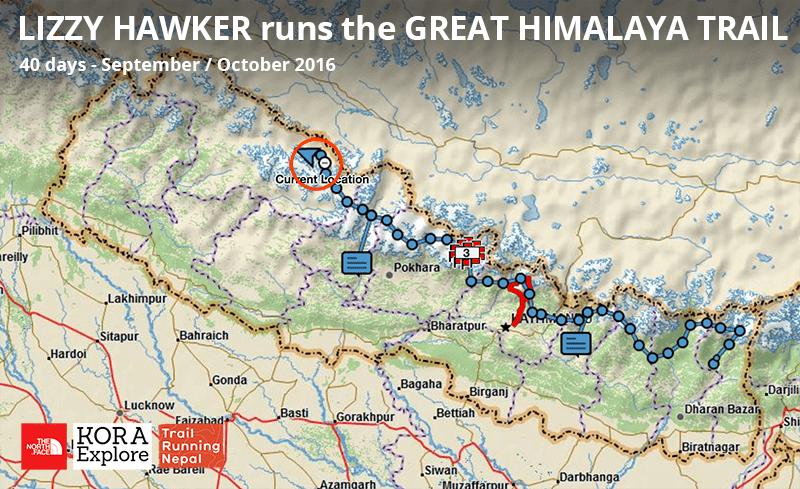
The Great Himalaya Trail is a vague concept, really a network of trails through the Himalayas. When you set foot on the trails, it’s anything but vague: it’s tough, wild, enormous, humbling. Lizzy Hawker, as you may know, has a passion for making long solo journeys across tough terrain. In 2011, a attempt to cross Nepal failed, losing the way in a terrifyingly dense forest on a steep hillside, and losing satellite phone, money, permits too. It took four days to escape from the forest. This 2016 attempt is looking much better, with 5 years more experience gained. In between she’s run from Everest Base Camp to Kathmandu, 319km in 60 hours, and recently the Tour of Monte Rosa, a brutal 170km with 11km D+ in 37 hours.
Lizzy is, the time of writing, this far across:
And at the time you read this, she is this far across.
The Great Himalaya Trail is some 1600km east to west climbing more than 2km of height per day, maybe 100,000m in total. Moving across Nepal crosses all of the major rivers that cut deep into the Himalayas. Anyone who’s walked in Nepal’s hills will know the scale of the ups and downs.
At the point she is at now around two-thirds is done, and now it gets tougher than ever. The high altitude passes of Dolpa: traveling in thin air over 5000m high passes 6 or 7 times, then into an area of no habitation for nearly a week, crossing difficult terrain like this on the faintest of trails.
And so, as written on her fundraiser page: It’s hard to stay fit and healthy on a journey like this. Hundreds of thousands of footsteps from dawn til dusk in wet shoes, climbing more than twice the height of Everest every week, falls (pic), cuts & scratches, the leeches (pic), snowblindness, losing the way, sleeping under the stars (or rain clouds) and (almost) all solo. How do you keep up the mental strength to keep going?
Having a cause to work for helps.
Lizzy wants to raise money to give opportunities to Nepali runners, particularly girls. She’s seen the impact Mira Rai’s success has had on Nepal, inspiring girls across the country. That started by a chance meeting and a subsequent donation of $360 from a woman to pay for Mira’s food and lodging while she learned about trail running.
Not everybody can be Mira Rai. But girls should get a chance to be the best they can be. Opportunities like these can change lives, give new perspectives, and especially in countries like Nepal, can maybe help to change the view of women’s place in society and prove women can be champions too – amazing, inspiring ones. This is why we need your help.
And of course it can be fun, challenging and exciting too.
With every donation, we’ll send a message to Lizzy’s tracking device. This will keep her going forward on this enormous, bleak terrain and finish this 1600 km and 100,000m of climb (1000 miles, 328,000 feet) on the world’s biggest mountain range.
Thanks for your support!
We’ve set up a crowd-funding page linked to a newly started NGO in USA, Athletes for Athletes (ASA), set up by Molly Mikita in Breckenridge, Colorado. Molly runs the Vertical Runner store there. After visiting Nepal and following the stories of Nepali athletes she onboard with Trail Running Nepal to fundraise for athletes. This is great!
Please note the following. Generosity.com only charges the credit card provider fee, around 3%. However it offers you the chance to donate 15% of your fee to them too for the service, which you may or may not want to do. Click images below:
Paypal is also great, via molly@myawesome.org to the USD account of the US registered charity ASA.
Do you want to donate by bank transfer? Send an email and we’ll send you details.
Sep. 16
<
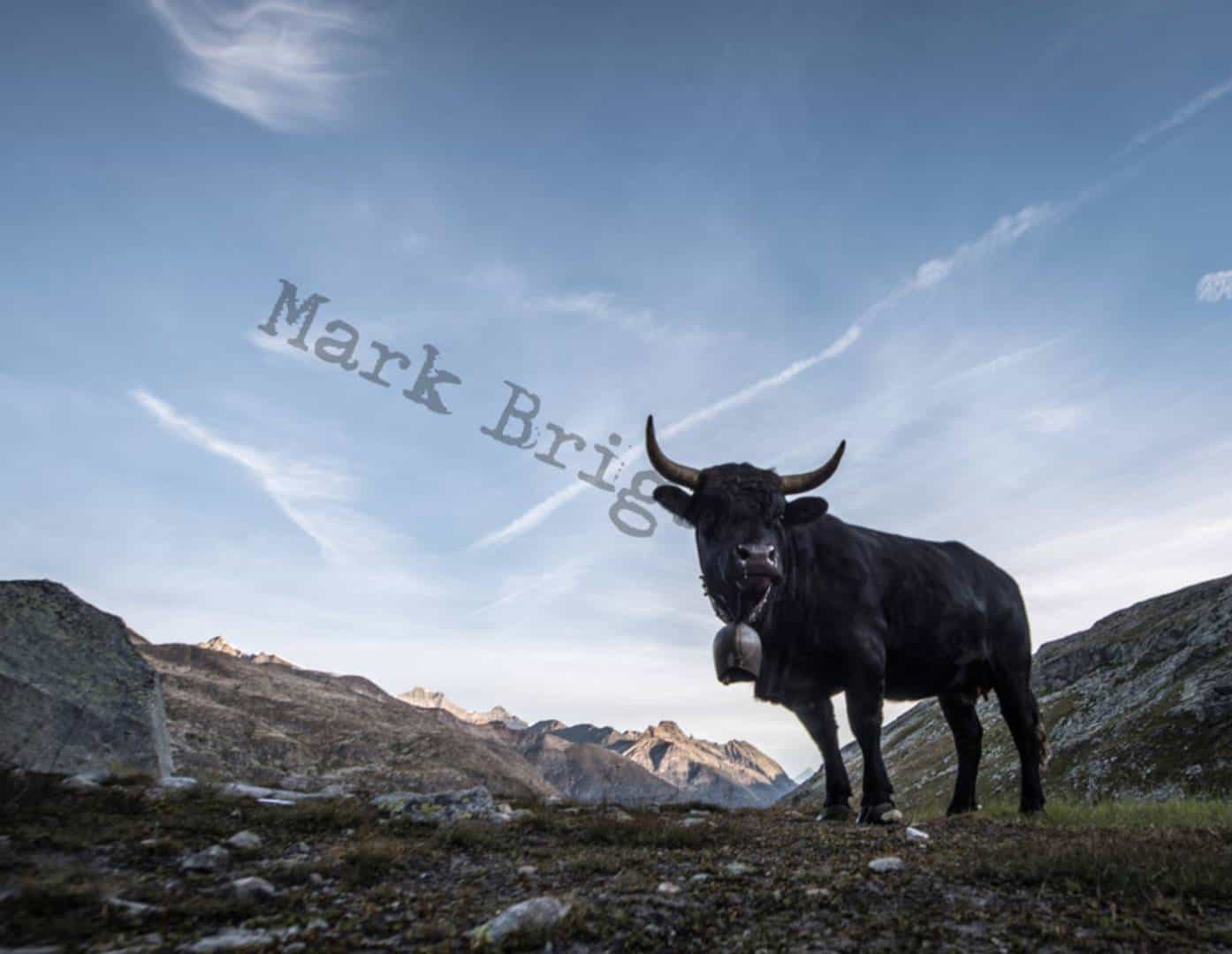
Mark was standing below the Monte Moro pass on the Swiss side. While monitoring the runners down the slope, he kept his camera busy.
Mark wants to offer printed copies of his images to you for a reasonable price in order to collect money for Trail Running Nepal’s athlete fund. The athlete’s fund raises money for trail running athletes to travel, buy good shoes, gels etc. i.e. everything needed to get to the start line with the best chance to compete. See Bhim at Kima and Tirtha at Ultraks. Mark has lived and worked in Nepal and knows that this talent needs support.
Check the images below and if you want to buy one, you’ll get a great memory for a reasonable cost and be assisting runners from Nepal like Bhim and Tirtha to have more chances to race.
https://markbrightwell.shootproof.com/gallery/3184932/
Aug. 24
<
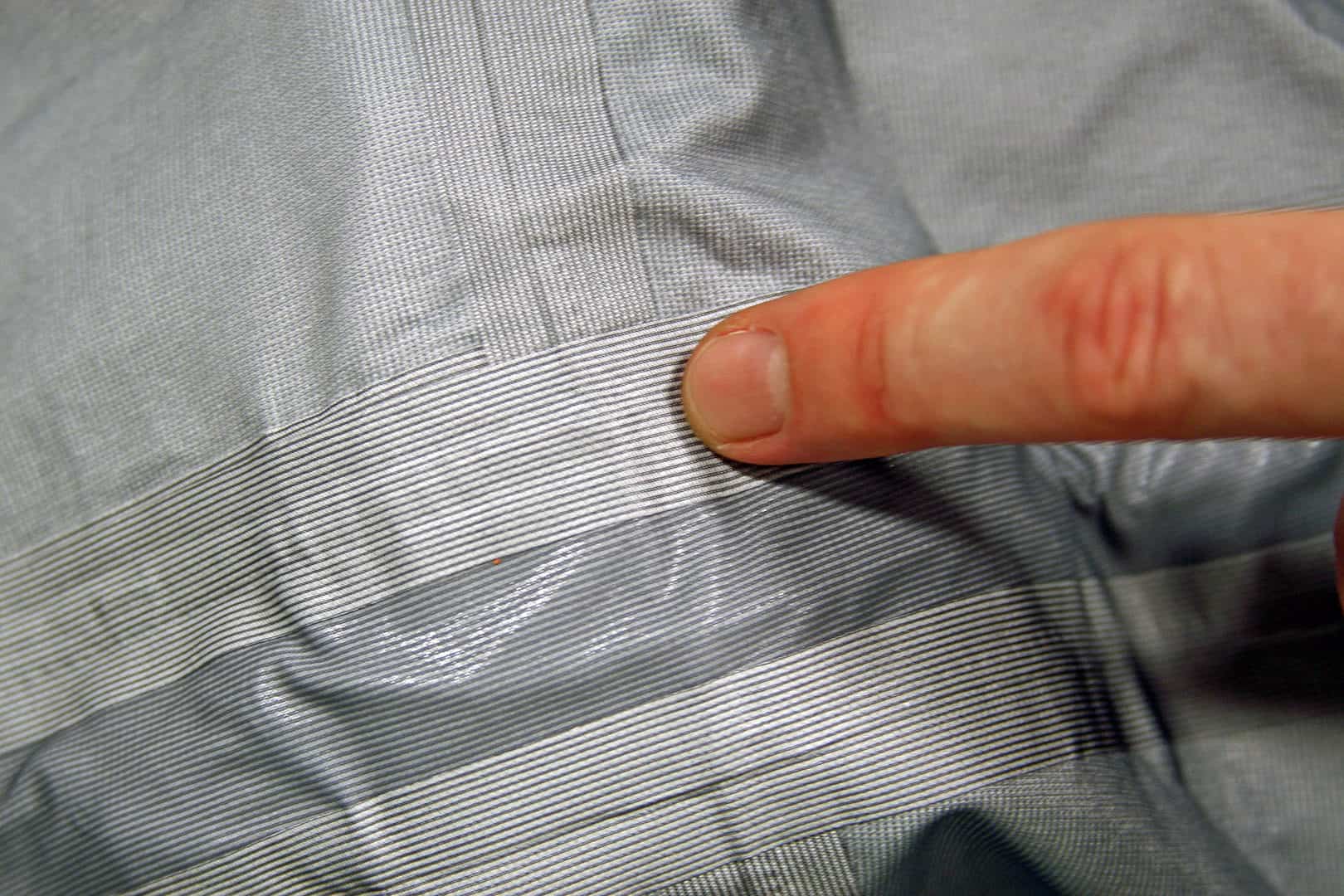
Runners, with one week to go we would like to highlight the importance of the obligatory equipment.
“There is no such thing as bad weather, just inappropriate clothing.”
I have just attended an event that was hit by severe wind and rain for the full 5 day duration of the event.
Most competitors managed their own safety well, but a few had poor equipment for the conditions or did not know how to manage their own safety in the mountains. This gave the organisers a huge problem in order to manage the race and avoid any injury to competitors. We therefore feel it appropriate to highlight the obligatory equipment requirements for the UTMR and help clarify requirements.
Clothing, and in particular waterproofs, are the difference between a successful race or a potentially dangerous situation for the racers and organisation. As the UTMR is in the high mountains it is important to make sure the clothing layers are suitable.
Your outer layer must be FULLY WATERPROOF AND BREATHABLE WITH TAPED SEAMS TO COVER THE FULL BODY.
This is obligatory for very good reason so please do not turn up to this race without these important items. These items are carried in case you or a fellow competitor injures themselves and cannot seek shelter. The safety team need to know you can stay safe while they attempt a rescue.
A good layering system allows competitors the best chance to manage their own safety on the mountains and reduce the risk of injury or death from hypothermia. A key skill of an ultra runner is to master their environment and an important part of this is to manage their clothing systems. If it rains then competitors and their clothing will get wet, a good waterproof will delay this far longer. Sweat that is not wicked away from the skin from climbing uphill can quickly cool and put the competitor in danger at higher altitudes, so cotton is not allowed as a layering material.
A good base layer that dries quickly and removes moisture away from the skin is the most important but least expensive item of clothing in the system.
An insulating layer that dries quickly and does not absorb moisture will extend the extreme level of conditions you can stay safe in. A fleece for good weather forecasts or a thicker insulating layer for bad weather would be ideal.
Finally the waterproof breathable layer allows it all to work. Without a good waterproofness rating the moisture will force its way in under rucksacks and zips, particularly in strong winds. Without a good breathability rating the moisture that manages to get into the jacket or your own sweat with stay there and increase the speed of hypothermia.
A plastic type jacket is waterproof but not breathable, and a windproof is breathable but not waterproof.
Both these forms of shell are dangerous in protecting the athlete in the high mountains. At equipment check we will be looking at the quality of your waterproof, and insuring they have fully taped seams. Without a tape on the seams they are not classed as waterproof.
Remember a windproof is not appropriate for this event even if it has passed other ultra equipment checks as we hear this excuse regularly. If you are unsure, please contact the manufacturer of your waterproofs, or send us an email.
Make sure you check this before arriving at registration for UTMR as we do not want you to have an additional unnecessary expense.
There is no such thing as bad weather, just inappropriate clothing.
Good luck and may the sun shine on all of us (oh and don’t forget sun cream!)
Anthony Emmet
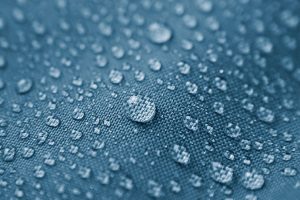 PS. I would probably add that they should all be washed and reproofed as a jacket that doesn’t bead the water off doesn’t breathe. That might be just a step too far for most.
PS. I would probably add that they should all be washed and reproofed as a jacket that doesn’t bead the water off doesn’t breathe. That might be just a step too far for most.
Aug. 06
<
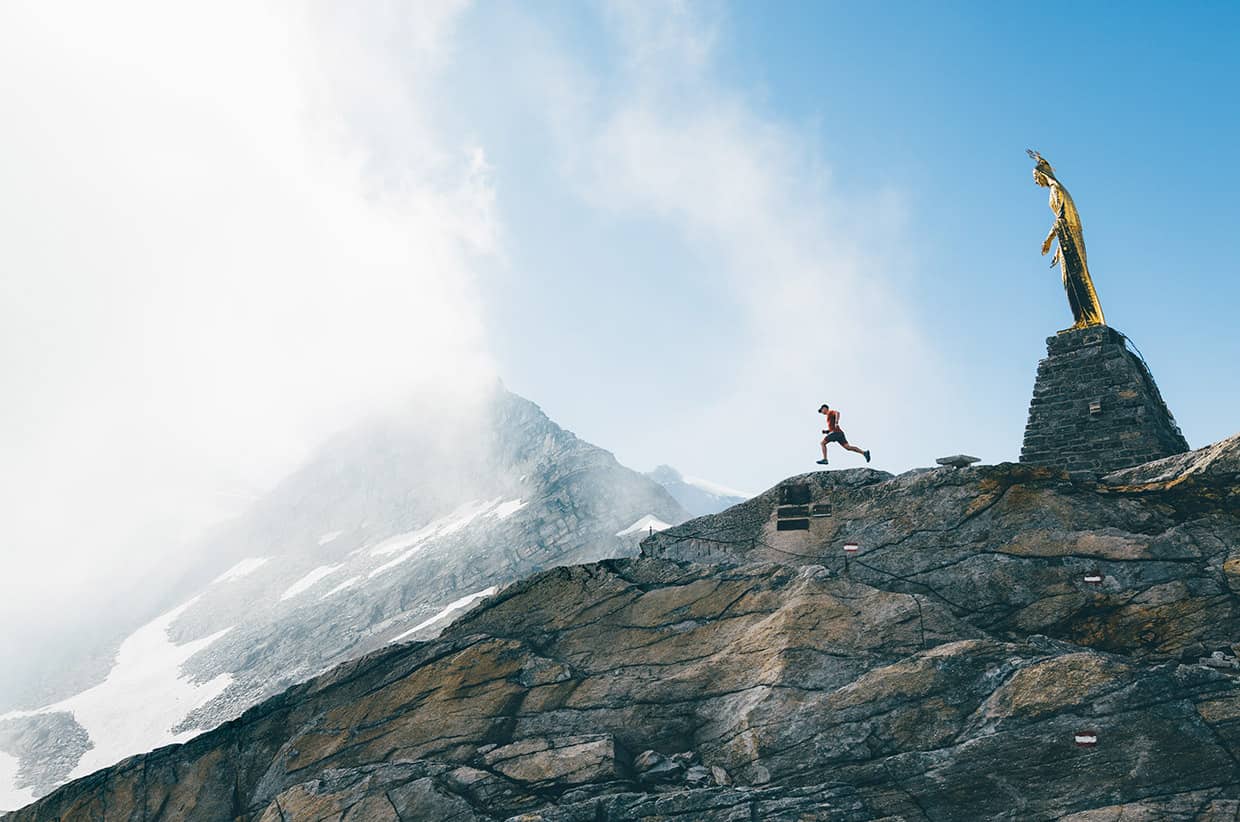
„The terrain was rougher than we could possibly imagine. It was in stark contrast to the flowing trails that we’d encountered while racing the UTMB (Ultra Trail du Mont Blanc).“
Ben Read and James Noorkoiv’s account of a summer fastpack adventure on the Tour de Monte Rosa. The threat of a storm forces them to return to Alagna in the end, but not before enjoying some adventure, and collecting some beautiful photos on the way.
Read on here:
http://www.sidetracked.com/tour-of-monte-rosa/
Aug. 15
<
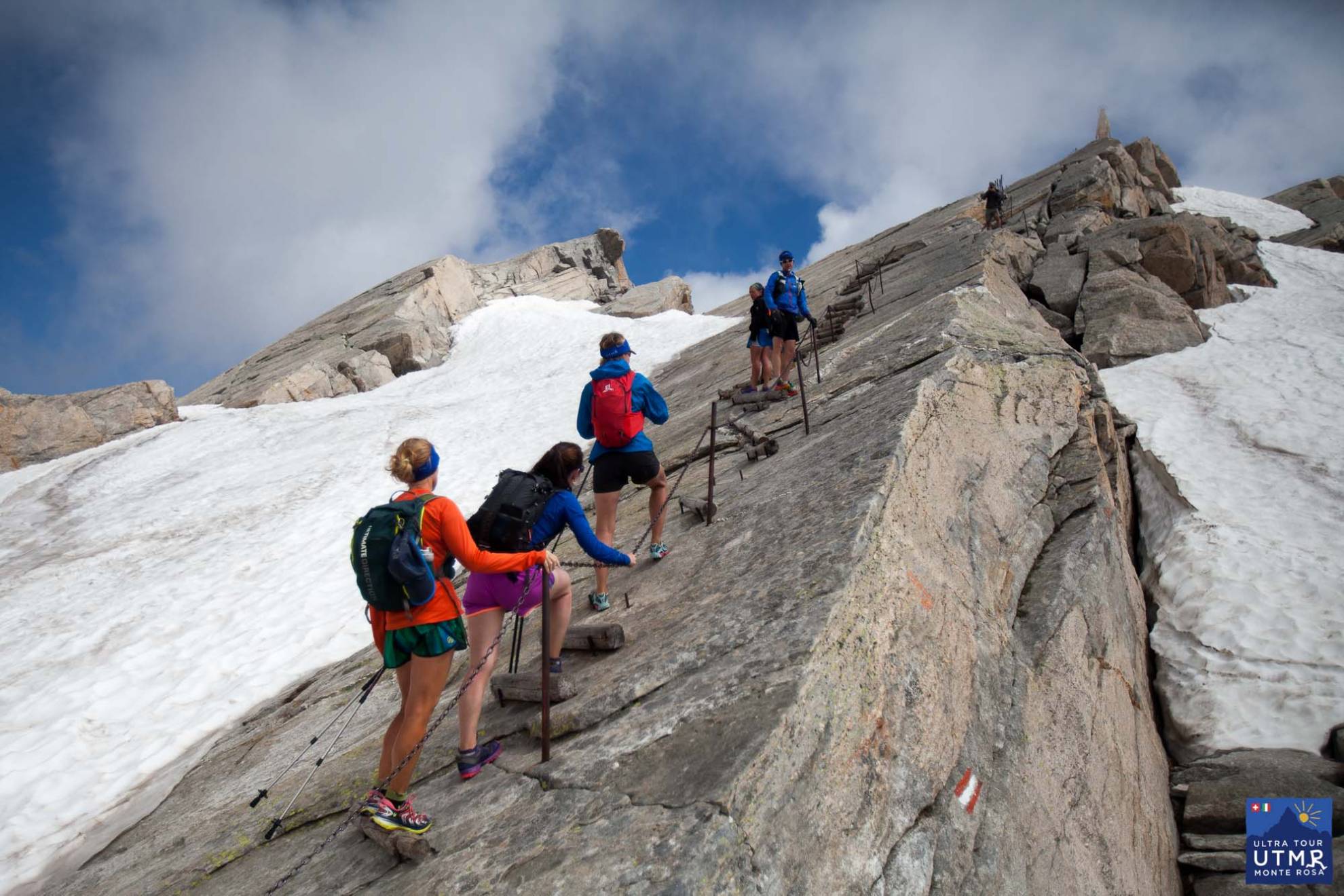
Lizzy Hawker runs training camps around Monte Rosa. These are part UTMR trail familiarisation trips, part running training camps, part trail running instruction from Lizzy, if you ask her nicely. Covering around 170km in four days with some 11,000m of elevation change is a fantastic boost to your training for trail. It’s great preparation for UTMB runners, indeed this was Lizzy’s own training camp for the Ultra-Trail Mont Blanc trail race for many years, though in two days rather than four. (Recently she tested how the full Tour de Monte Rosa route course felt in one continuous run.)
This is the full 2017 route, not split into stages. There will be a four-stage race alongside the ultra.
39.5 km D+2554, D-2538
The route follows the Europaweg with fantastic views in clear weather of one of the world’s iconic mountains. More about the first 40km here.
It’s worth mentioning the fantastic stone-carved statue of ogre-kill warrior after the first climb, just 30 metres off of the trail. Hopefully your own legs won’t feel as heavy as rock by then.
The trail is technical and tiring, but you’re rewarded in the last few kilometres with the fast the descent into Zermatt – a really enjoyable section with the pine needle covered forest trails.
Leaving Zermatt, there is a long climb to 3300m, the highest point on the route, Theodul pass. This comes close to the Matterhorn and you have fantastic views towards it and back down to Zermatt and the whole valley (in clear weather).
A small steady descent to the Lago Cime Bianchi (and a checkpoint) before a climb to Passo Cime Bianchi, and a steady descent to Rifugio Ferraro for an amazing feed. A last steady climb to the wild Passo di Rothorn, before the descent to Gressoney-la-Trinité.
This is probably the easiest terrain of the four days, with lots of trail and path. In September there will be much less snow than appears in these pictures taken in July.
43.23 km +3679, -3995
Two major climbs in this stage. The first to Passo dei Salati, a steady climb with checkpoint at the pass. Here you have a good chance to see sturdy-horned, shiny-coated Chamois / Ibex here. If you don’t see one, there is a alive-looking statue at the pass.
There is a fabulous, wild run down to Alagna, and an aid station with great food. Leaving Alagna, there is an easy 4km on tracks before a steep climb to a rifugio (spring water). From there a long wild section: a long climb to Colle del Turlo (2700m) and down to Quarazza (CP) and 4km further to Macugnaga. This pass is a medieval road, rebuilt during war time. A trail made from blocks of stone make the ascent easier (easy angled, but longer) and the descent difficult requiring focus until reaching the valley bottom.
44.67 km D+2844, D-2518
After a steep climb to Passo Monte Moro, with incredible views to the Monte Rosa massif, a long descent (technical at first) into the Saas Valley. The reservoir is a major landmark and gives a kilometre of flat, relaxed running.
After the reservoir, the final 3-4km to the Saas Almagell is over lots of boulders and extra attention is required to keep to the marked trail. A well stocked checkpoint at Saas Fee gives you a rest before joining the Höhenweg to the Hannigalp checkpoint, and the steep 700m descent to Grächen.
There it is. Far from easy! Follow the progress of the 2016 race on Twitter and join our mailing list via the form below.
(Thanks Fergus Edwards for comments and suggestions.)
Resources:
GPX file: UTMR 2017 gpx file
KML file: UTMR 2017 Google Earth
Sep. 28
<

UPDATE: Lizzy completed in 37 hours 10 minutes
The climb is more than Everest from sea to summit, and fortunately the distance is much shorter than bay of Bengal to Everest’s top. But the comparatively short 169km on mountain trails with over 11,000m of climb and descent, all at an average altitude of around 2200m, is going to feel very long. Especially alone.
After three Everest Base Camp to Kathmandu “mail runs” (319km, 62 hours), a tour of the Annapurna circuit (circa 220 km, crossing a 5400m pass), the Manaslu Circuit (162 km, 5160m pass), and a recent birthday ~120km turn around the ring of hills around the Kathmandu Valley in Nepal, Ultra Tour Monte Rosa race director Lizzy Hawker is well practiced in this genre of attempting Fastest Known Times (FKT), or Only Known Times, or simply long, hard solo journeys with little sleep that, realistically, few other people are capable of doing.
At the time of writing, Hawker is eight hours into her run and hike, according to her tracking device, she’s on the long hike up from Zermatt to Theodul pass at 3300m. In clear weather, the view towards the Matterhorn is a treat. The view away from the Matterhorn is a treat too for that matter.
Views aside, why is she doing this? “I need to have done this myself a couple of times before I can send people out to do it for themselves,” she says, adding, “albeit in an easier context of a race – aid stations, security, dropbags, supporters and co-runners etc.”
Hawker has probably completed the Tour of Monte Rosa more times than anybody else.
“Yes, you can say I’ve done it many times over two long days [as UTMB training], and more recently as a training camp in four days, but this is the first nonstop attempt.”
Beyond this, to make arrangements for the race, she has found it easier just to go on foot and take cable cars to visit the race’s guides, checkpoint teams and hoteliers. To drive to each checkpoint one by one would take 17 hours (857 km) or 13 hours (636 km) for this year’s shorter 116 km course starting in Cervinia.
Regardless of this experience on the Monte Rosa trails and experience of ultra long foot journeys, Hawker says, “I’m actually surprisingly apprehensive given the number of times I’ve run that distance, run through the night etc. it’s the not knowing what my body and mind are going to do, or how I will react or deal with it. I’m kind of caught between the known and the unknown. I know the route so well, but doing it in one go without support is something different.
“The [period] before is harder, once started then everything else falls away and it’s just a journey. It’s nice to focus on something, to make a journey from start to finish and kind of suspend the everyday.”

If she completes it without problems, then she says, “as a bonus it will make a soft target for next year’s competitors to go for!” She will also be able to judge how demanding a challenge it is. It is harder than the tour of Mont Blanc, given the greater elevation change, longer climbs and the more technical trails. “I’ve estimated it will take runners 20% longer to complete,” says Hawker.
There are many things that could thwart the non-stop goal of course, bad weather being one. Another is a very busy race director’s inbox as the next race approaches, just five weeks away.
Follow Lizzy on her Open Tracking page. Information about the 2017 Ultra Tour Monte Rosa will be available in early September. Join the mailing list to stay informed.
Jan. 10
<
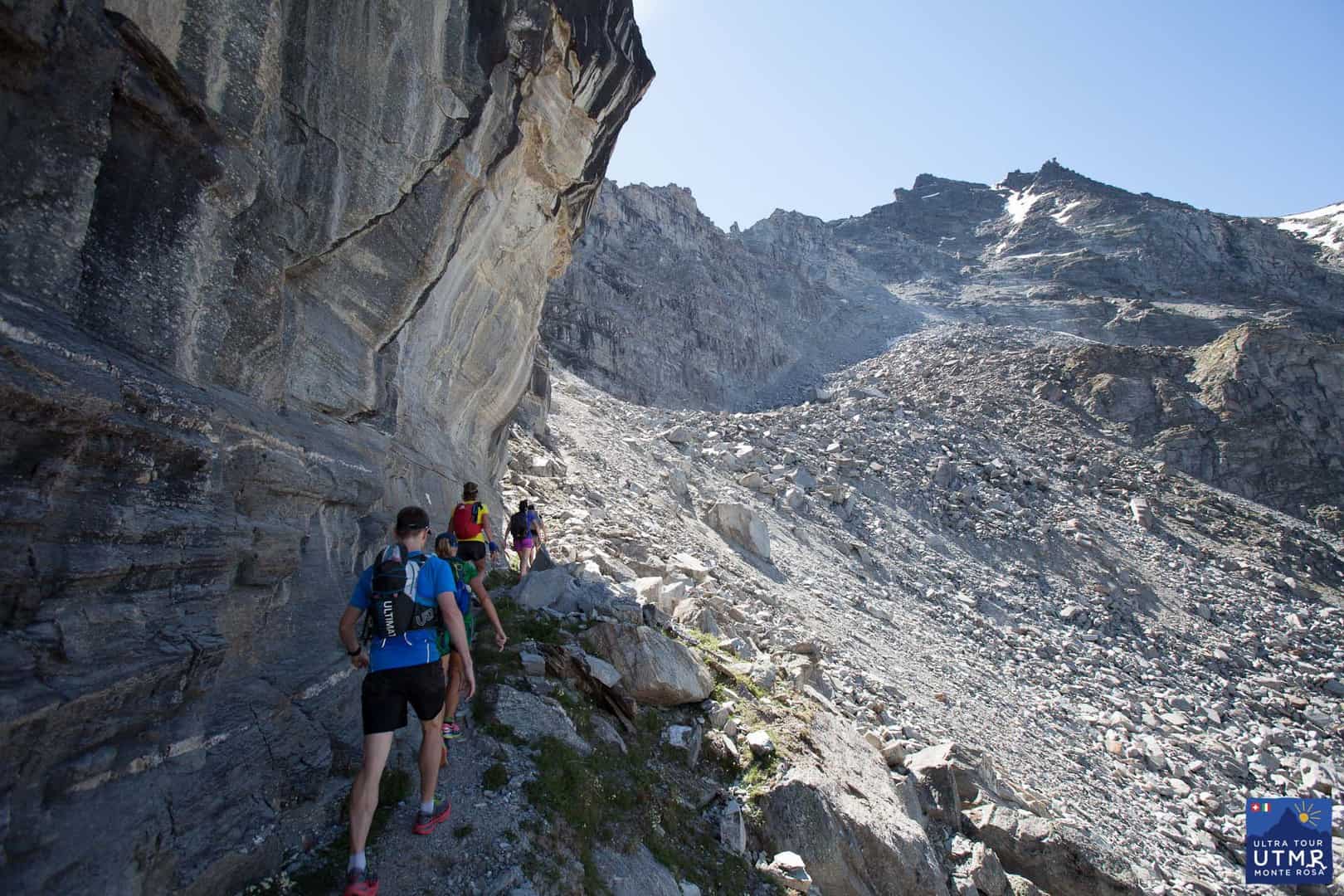
We’ve just held 2016’s first UTMR training camp – completing the full tour of Monte Rosa in four long days. A mix of running the downs and hiking the ups, to get familiar with the course and get long hours on our feet. It’s the kind of course that needs that. One of the participants, Fergus Edwards, was asked to give his opinion on the course as it will be in 2017, including the 40km section from Grächen to Zermatt along the Europaweg.
From Fergus:
If it’s a fair course, one that is an existing trail and that can, in theory, be completed without needing to sleep, then it’s probably about 100 miles long and up in the mountains somewhere.
It’s going to be tougher if it’s up higher, if the elevation profile is sharper, if more of the terrain is technical, and if the weather changes are likely to be severe. That’s going to make it harder to breathe, harder on the muscles and joints, harder to get into any running rhythm, and harder to keep the body warm and working.
The UTMR course is going to destroy runners that think it’s just another long run in the mountains. This is not a race that you turn up at and hope to hike the ups, jog the downs, and make it back tired but inside the cutoffs.
Two key reasons: firstly, the ascents and descents are longer and steeper than other races; secondly, the terrain is technical with boulder fields and tight turns to narrow paths clinging to cliff edges.

Fergus Edwards at km 10 of more than 160km.
The elevation change is more than a Western States or a Leadville, but even beyond that the defining quality is the steepness. There are two climbs of over 1,500m, and one of those takes place over only 8km; UTMB has only one such climb and it takes place over three times the distance.
The technicality of the terrain is harder to convey but probably more important. These aren’t groomed trails of pine needles or dusty crushed canyon walls; these are boulder fields or granite strewn switchbacks. Only the most technically competent runners are going to be able to move consistently, and no-one is going to be keeping a loose, even stride.
The physical stresses only magnify the impact of every decision the runner takes as the night closes in, the temperature drops, and as the weather changes. The ability to think and intelligently adapt will be at least as important as the ability to switch the mind off and move.
This is the way ultras began: with a competition between each runner and a raw, brutal, beautiful course. It’s why every finisher is celebrated: because at UTMR, not everyone is going to finish. Not by a long way.
+++
There you go! One man’s educated opinion. For reference, Fergus has run races, and made fastpacking trips, all over the world, and so he knows his trails and has something to compare the UTMR trails to. He’s run TDS (2015), CCC (2014) and many of the Racing the Planet races (all 250km self-supported, carrying all own kit) and The Four Deserts (Gobi March (9th)), Atacama Crossing, Sahara Race, The Last Desert (10th)). and the Roving Race (Ecuador) where he was the Winner, Team Competition.
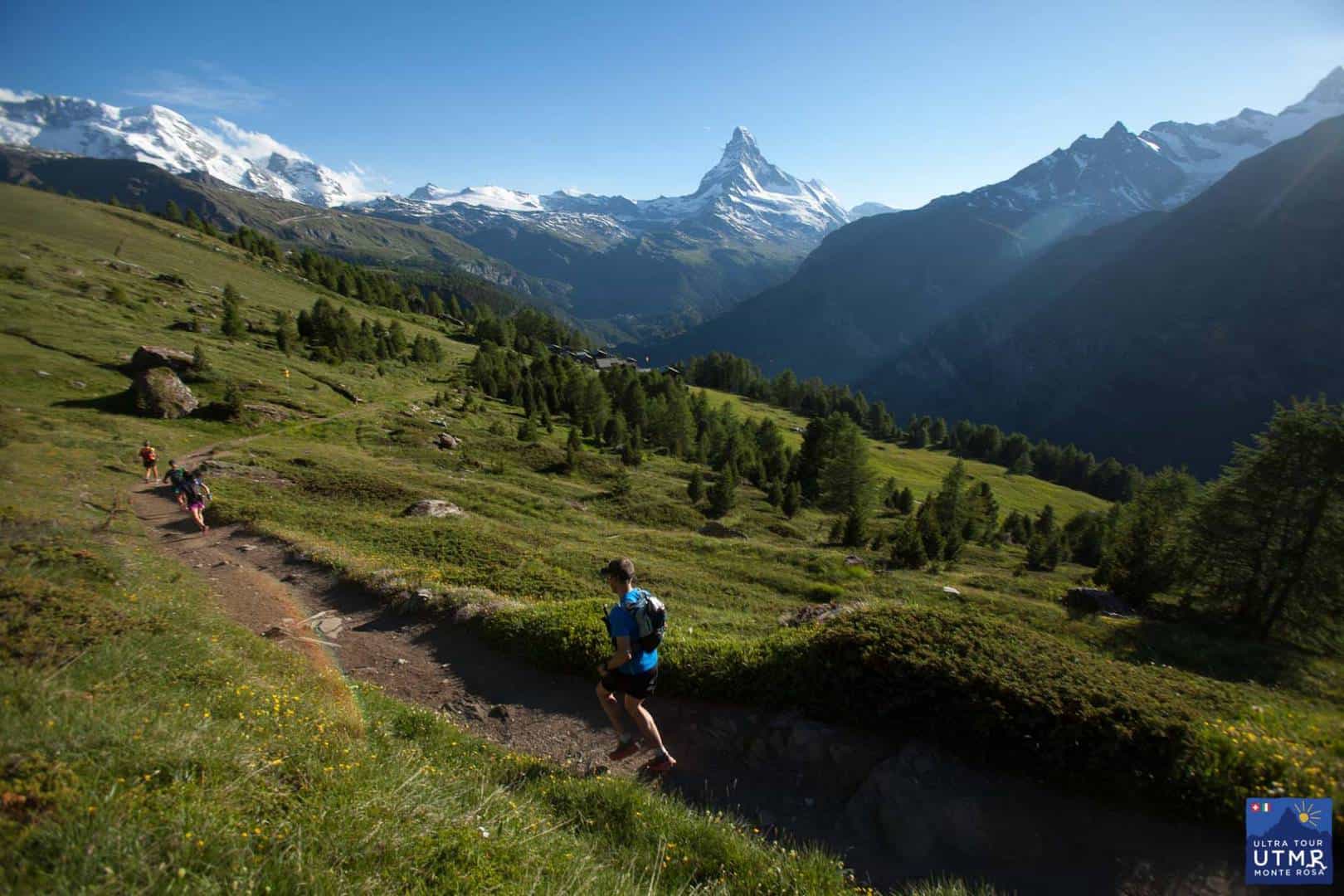
Fergus in his stride on the way to Zermatt.
Aug. 12
<
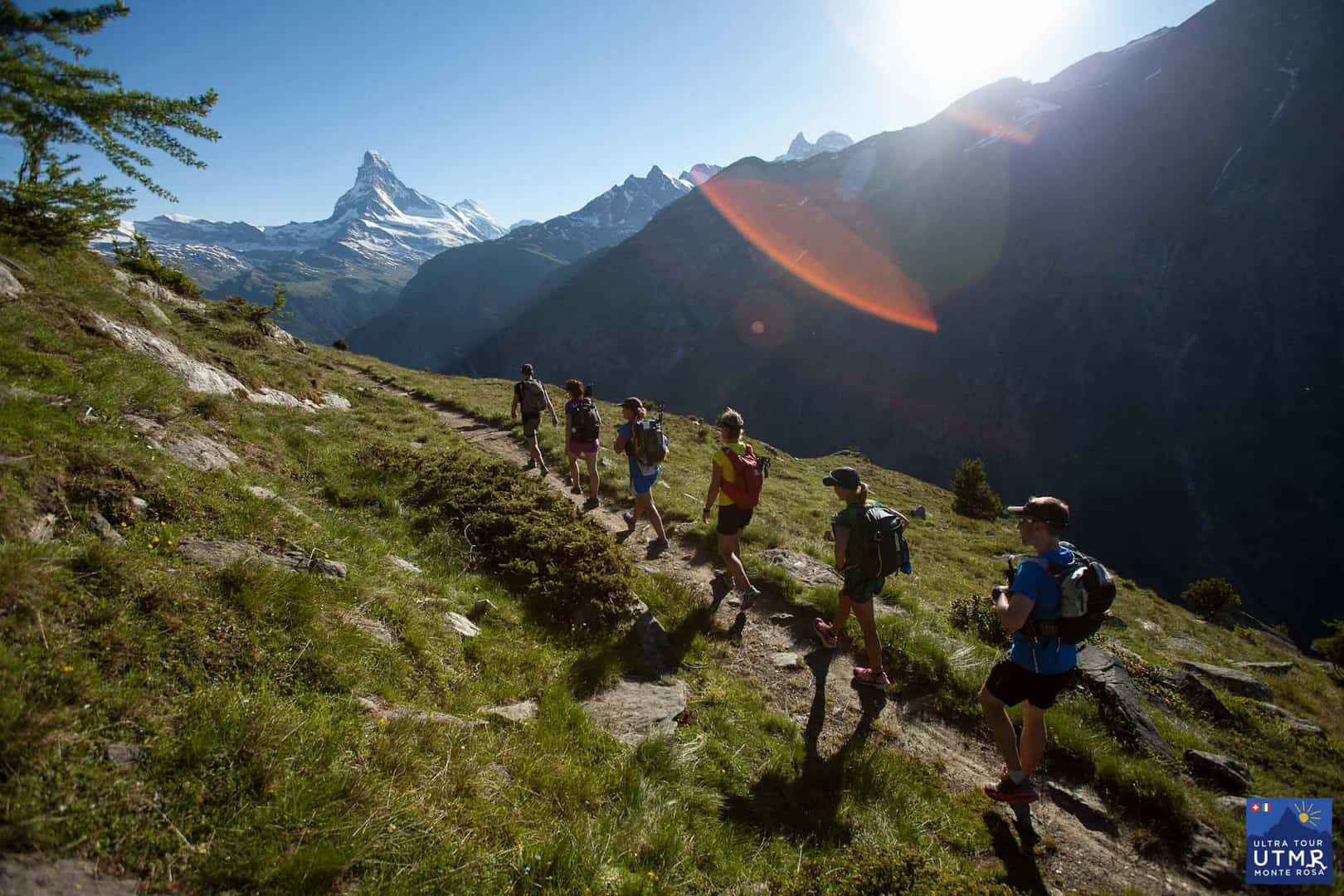
The 2017 ultra will be a full tour of Monte Rosa, from Grächen to Grächen, with a 4-stage race along side. This nicely builds upon the experience from the stage race only zero edition, and 2016’s single stage ultra along side the stage race. 2017 thus adds the Europaweg from Grächen to Zermatt, and the crossing from Switzerland to Italy.

On the way to Zermatt!
So how is the new section of trail that has not been run yet? Well, it’s wild! Here’s a Google Earth map.

Google map and profile for Day 1 of the UTMR training camp. This is the 2017 route!
From Grächen, after a flat warmup, it’s a kilometre climb over 5km to get on the Europaweg. From here the views are excellent, but the trails are challenging: narrow and rocky. You can see from the photos below, passing will be difficult in places, and runners will be challenged by crossing boulders on landslides.
There will be a checkpoint at around 15km, the Europahütte, and shortly after here, a bridge across a gorge is closed, which requires a 700m descent followed by a 700m climb again.
The trail has some wonderful runnable sections, but is always climbing or descending. Towards the end the trails towards Taschalp, and then onwards to Zermatt are beautiful, dream trails even if the weather allows a view to the Matterhorn.
Below are GPX and KML files for the route so you can inspect at your leisure.
After Zermatt there is another substantial climb before the route connects with the 2016 route. It will pass over the Theodul glacier and pass over into Italy near Furggsattel at around 3340m. The two checkpoints here will be:
Then the 2017 route continues as the 2016 route. A GPX / KML track will be released soon which will give distances and elevation changes.

Kommentar verfassen